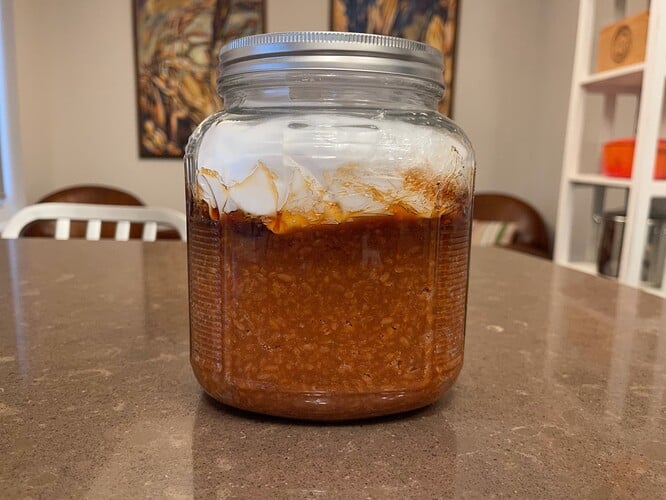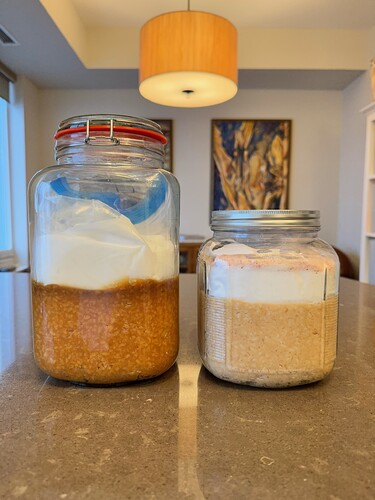365 days ago I started out to make homemade miso. You may know that I like miso based on my various miso sourdough breads I’ve posted here. Today I finally tasted it and used some in a dish for dinner. I have to say it was worth seeking out the koji rice, homemade miso is much more flavorful and complex than the store bought stuff I’m used to.
The following is from the justonecookbook.com website and worked really well. I used my instant pot and it made it a breeze.
HOMEMADE MISO
Prep Time 30 mins Cook Time 1 hr 30 mins Soaking Time 18 hrs Total Time 20 hrs
Make Homemade Miso from scratch with just 3 ingredients and a little patience. My simple step-by-step instructions on How to Make Miso will guide you through this process. Once it is made, you can use the amazing fermented paste for many delicious Japanese dishes!
Course: How to
Cuisine: Japanese
Keyword: miso
Servings: 3 kg (6.6 lb)
Author: Nami
INGREDIENTS
- 650 g soybeans (1.43 lb)
- 1000 g rice koji (5 cups) (2 Cold Mountain packages)
- 375 g Arajio natural sea salt (13.2 oz)
- ½ Tbsp Arajio natural sea salt (for sprinkling)
INSTRUCTIONS
January/February
-
Gather all the ingredients. Besides this, you will need 2 large bowls (one should be a very big one), 1 strainer, Instant Pot (or pressure cooker or a large pot), a clean cloth, alcohol (shochu or vodka), a potato masher (or a food processor), a 1-gallon glass jar to put miso in, and a bag of 1 kg (2.2 lb) table salt.
-
Gently wash the soybeans thoroughly several times under running water.
-
In a large bowl, add the rinsed soybeans and fill the bowl with filtered water to about 5 inches (10 cm) above the beans. Soak the soybeans for 18 hours.
-
Drain the beans. Look how large the beans are now. The right soybean is before soaking, and left two soybeans are after 18 hours of soaking. After soaking, total soybeans weigh 1435 g.
-
Add the soybeans into the inner pot of Instant Pot. Fill the pot with filtered water to about ½ inch (1.2 cm) above the beans (roughly 8 cup line of the pot).
-
Close the lid and set HIGH pressure for 20 minutes. Make sure the steam release handle points at “sealing” and not “venting”.
-
STOVETOP OPTION: Alternatively, you can cook the beans on the stovetop. Bring to a boil over high heat, skim off the surface scum, lower to a simmer, and cook for about 3-4 hours, uncovered, until the beans are soft. Add water as needed during simmering to keep the soybeans submerged in just enough water.
-
Meanwhile, in a large bowl (You will add mashed soybeans in this bowl, so use your largest bowl/pot/container/dish), combine the rice koji and salt with your hands.
-
Also, put some alcohol (shochu, vodka, soju, sake, etc) on a clean cloth and wipe inside the jar you will put miso in.
-
Once the pressure cooking is finished, release the pressure naturally. It will take about 30 minutes till pressure comes down completely and you can open the lid.
-
Test if the beans are done, by pressing a bean between a pinky and thumb. If it is mashed nicely, it’s ready. Drain the soybeans over a bowl to capture the cooking liquid. NOTE: When you are mashing the beans, you may need some cooking liquid, so save about 1 cup just in case. Ideally, it’s best not to use the cooking liquid at all (for this particular recipe, which is designed to make miso without adding cooking liquid). Water in the miso has a higher risk of potentially causing mold growth in the miso.
-
While the soybeans are still hot, transfer some of the soybeans back in the Instant Pot inner pot and mash them with a potato masher (pestle or bottle, etc). Do this process in batches so it’s easier to mash nicely.
-
If you have a food processor, process some soybeans until they are paste form. Do this process in batches so it’s easier to process.
-
ONLY if the soybeans look really dry, add a small amount of cooking liquid. As I mentioned earlier, it’s best if you don’t add it in this recipe. Scoop out the paste and continue with next batch.
-
Mashed soybeans must be warm/room temperature (NEVER hot) before combining them with the koji because hot soybeans can kill koji mold. Mashing takes time unless you make a small batch, so you don’t need to worry about the soybeans being hot in this recipe.
-
Add the warm (not hot!) mashed soybeans into the bowl with the koji and salt mixture.
-
Knead well to distribute the rice koji and salt with mashed soybeans. Take time to do this process until it’s mixed well.
-
Using your hands, form tennis ball-sized balls with mashed soybeans.
-
Put each ball into the container and mash it with your fist and knuckle to ensure that all air pockets have been eliminated. Do one layer at a time, and make sure to press down tightly. If you have a glass jar, you can see if you miss any pockets by looking from the side of the jar.
-
Repeat this process until all the balls are pressed tightly in the jar. Pat down the surface with flat of your palm or knuckle to smooth out. Make sure you have a space left for the weight on top of the miso. If your jar/container is too small, use another container. Clean the inside surface walls of the container with a shochu-soaked cloth/paper towel to deter mold.
-
Sprinkle ½ Tbsp of sea salt on top of the surface.
-
Place a plastic wrap on top of the surface and make sure to cover nicely. I use my adjustable drop lid (otoshibuta) to hold down the plastic wrap while I work on covering the edges and remove it when I was done.
-
Put heavy objects (or rocks) on top of the miso. I put 1 kg (2.2 lb) of table salt (cheaper than the sea salt) in a plastic bag and put it on top.
To Store
- Write down the date on a masking tape and put it on a jar. Place the miso in a dark and cool place for at least 3 months (I put in a storage underneath the stairs). You can also use a dark pillow case and try to find a darker spot in the house.
- After 3 Months (April/May)
- Stir the miso from the bottom up to avoid mold forming. When checking the miso, do so quickly to avoid exposure to air. If you see any mold on the surface, carefully scrape it off. Clean the inside surface walls of the container with a shochu-soaked cloth to deter mold. Smooth the surface, place a new plastic wrap on top, and put the weight back on top. Place the container back to a dark and cool place for another 3 months.After 3 More Months (July/August)
- During summer months, the fermentation will be faster but the chances of getting mold are higher. Stir the miso from the bottom up every 2-3 weeks and check your jar regularly and remove any mold appearing on the surface. Even if a layer of mold covers the entire surface, the miso below should be fine. Just scrape off the surface to a sufficient depth where only mold-free miso can be seen. Clean the inside surface walls of the container with a shochu-soaked cloth to deter mold. Smooth the surface, place a new plastic wrap on top, and put the weight back on top. Place the container back to a dark and cool place.When Miso is Done (September)…
- Remove the weights once the miso is done and store it in the refrigerator to prevent from over-fermenting. You can divide the miso into smaller containers so they will fit in your refrigerator. Now you can enjoy your own miso paste made with patience, love, and perseverance.
The miso 1 year ago
The miso today.
Sticky miso roasted chicken and sesame butternut squash I made for dinner to test drive my miso. Yumm.




